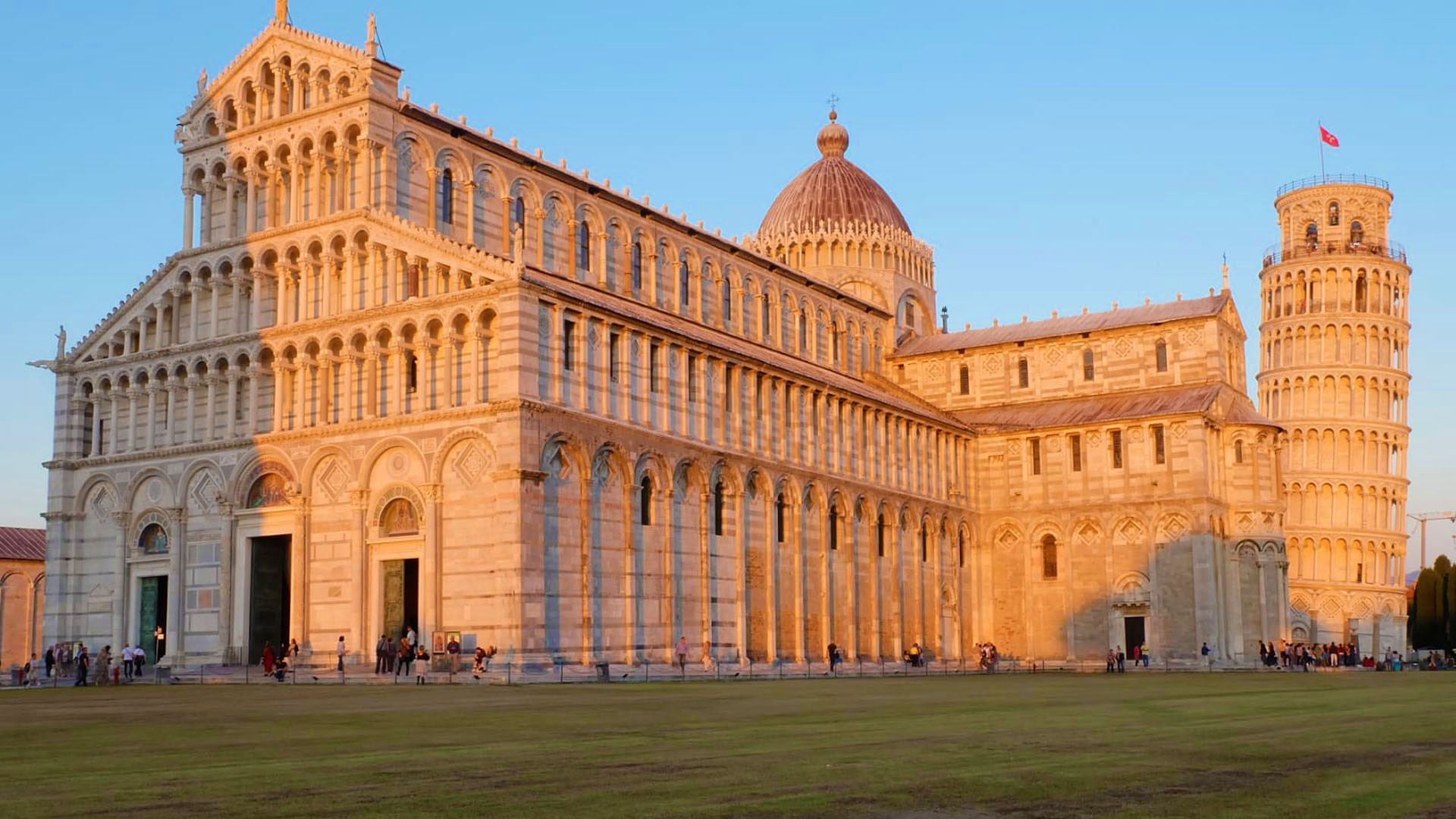No city is as closely associated with one single monument as Pisa is with her tower. It is a wondrous site but so are the cathedral and baptistery. Both owe much to the influence of Islamic architecture, which Pisan merchants and scholars experienced through trading with Moorish Spain and North Africa. Once a thriving Roman port, Pisa’s harbour silted up in the 15th century, and it is now marooned on the Arno river, six miles (10 km) from the coast. Great medieval sea battles were fought off these shores, with the city-state of Pisa becoming first an ally then a rival of other Tuscan states, including Lucca and Florence, along with the maritime powers of Genoa and Venice. Wonderful though the Leaning Tower is, many visitors fail to notice the treasures outside the Campo dei Miracoli. It’s certainly worth exploring Pisa’s other `miracles,’ from the riverbanks to the lively town.
Pisa
-
-
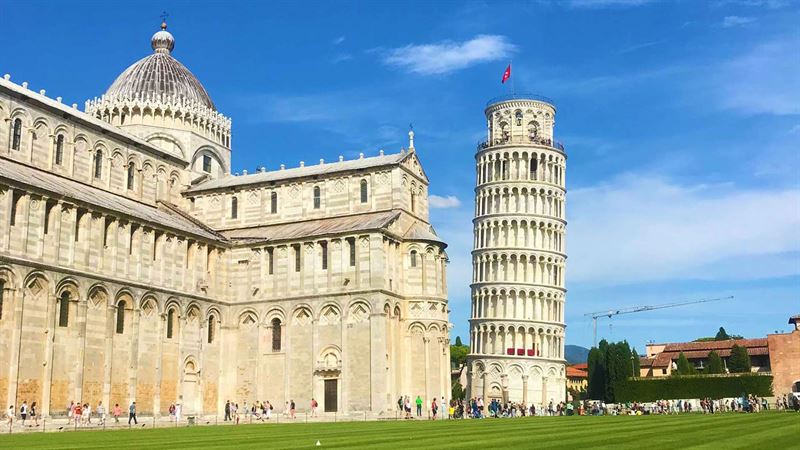
Top Ten Things To Do
Unlike most Tuscan cities, Pisa's religious centre is not inside the walls nor in the old town but marooned on the northern edge of town. Coaches decant day-trippers on the Campo Dei Miracoli, the `Field of Miracles,’ with selfies in front of the Leaning Tower the chief priority. Spare a thought for the rest of Pisa, which is full of intriguing corners.
-
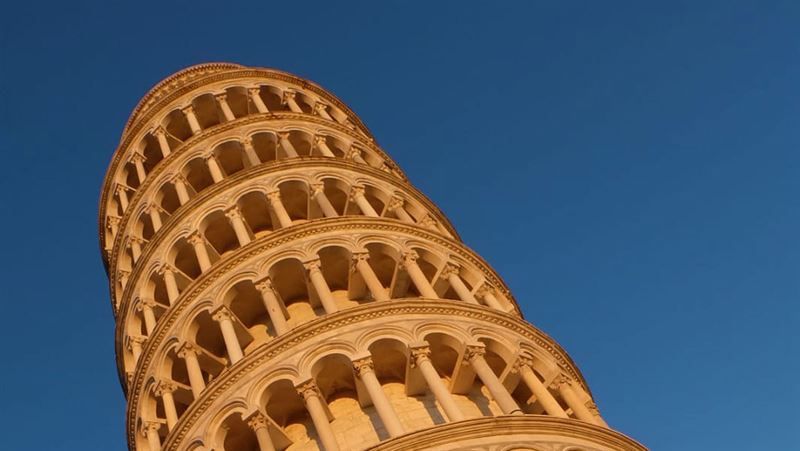
1. The Leaning Tower – wonder of the world
Pisa’s landmark really does lean to a frightening degree, though less than it used to. The Tower now slopes at an angle of 5° from the vertical and remains standing because its centre of gravity is inside the perimeter of its base. The unstable subsoil that underlies the Piazza dei Miracoli has caused all the buildings to tilt and subside to dizzying effect. Just to the right of the entrance to the Tower is a date stone standing for AD 1173, when building work started on the Campanile. But work stopped at the third stage because the building was already collapsing. A century later, three more stages were added, deliberately constructed to tilt in the opposite direction, so the Tower has a decided kink as well as a tilt. By 1989 the Tower was leaning to such a perilous degree that it was in danger of collapse. It was promptly closed, and an international team of engineers spent the next two decades in a battle to save it. During the first phase, completed in 2001, the tower was straightened by 40cms to avoid imminent collapse. In 1992 it was given a girdle of steel braces which were attached to a cunning counterweight system. A year later, the bells were silenced because of the damaging effect of vibration on the edifice. In 2011, the Leaning Tower was reopened but, given the complex challenges, it would be tempting fate to say that the Tower was safe forever. The best place to catch your first sight of the 12th-century Tower is through the archway of the Porta Santa Maria, also known as the Porta Nuova. When the sun is shining, the whiteness dazzles; when raining, it glistens.
Practicalities: visits are restricted to only 45 people at a time – children under eight are not allowed in while under-eighteens must be accompanied by an adult. Book in advance online or head straight to a ticket office when you arrive to book a 35-minute slot. It’s a steep climb of 251 steps. You can take up a camera but all bags must be left in the free left-luggage desk next to the main ticket office.
Address: Torre Pendente (Leaning Tower), Piazza dei Miracoli, Pisa
Web: www.opapisa.it -

2. Duomo – the prototype for Tuscan cathedrals
The candy-striped Duomo was the prototype for all Tuscan Romanesque cathedrals, with its contrasting bands of colour, blind arcading, colonnaded gallery and the geometry of inlaid marble. A hallmark of the Pisan style was its talent for selecting a theatrical space: in Pisa, the main buildings present a unified whole, as if they were placed there like chess pieces. The maritime republic of Pisa was an 11th-century power, trading with northern Europe and the Muslim world. As a result, the Pisan style is a glorious hybrid: austere Norman Romanesque inspired by a Moorish Sicilian aesthetic and the Tuscan taste for marble. Yet the colourful geometry of the multi-coloured marble is essentially Tuscan. The palette contrasts white marble from Carrara, rosy pink from Maremma and dark green from Prato. The Cathedral, built between 1068 and 1118, is one of the major monuments in Italy. The beautiful white-marble façade is studded with mosaics, inlaid marble and glass stones. The 16th-century bronze doors are surrounded by frames enlivened by animals. The majesty of the interior is created by the forest of pillars rising to arches of banded white-and-grey stone, and the colourful mix of altar paintings and Cimabue’s apsidal mosaic, from 1302. The magnificent marble pulpit by Giovanni Pisano (1301–11) is a masterpiece, supported by prophets and allegorical figures, with its dramatic panels depicting scenes from the Life of Christ. Hanging from the arch of the great dome is Galileo’s Lamp, so called because its pendulum movement is said to have inspired Galileo to discover the rotation of the earth (in reality, the lamp wasn’t here in Galileo’s day).
Practicalities: Even if admission is free you need a ticket from another attraction on the square to get in, or a fixed-time pas from the ticket offices behind the Leaning Tower.
Address: Duomo, Piazza dei Miracoli, Pisa
Web: www.opapisa.it -
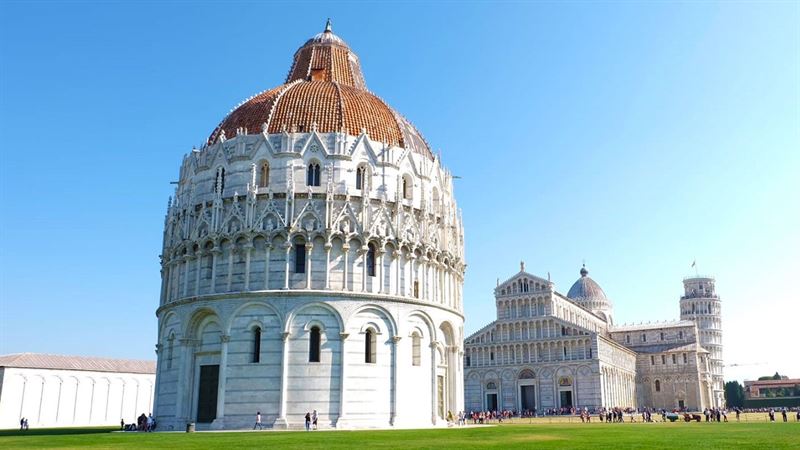
3. Battistero – Italy’s largest baptister
Also on the Campo dei Miracoli, a veritable Square of Miracles, stands the Battistero, the largest baptistery in Italy. Begun in 1152, it was remodelled by Nicola and Giovanni Pisano a century later, built in the same Pisan Romanesque style as the Cathedral. This round, arcaded affair is richly decorated with niches and statues of saints. The interior is far plainer, but it has one great treasure: Nicola Pisano’s hexagonal pulpit of 1260, carved with scenes from the Life of Christ. The masterpiece was clearly influenced by Ancient Roman art, notably by Roman sarcophagi in the Camposanto (see below). Mary, for example, has the long neck, veil and ringlets typical of middle-aged matrons in Roman portraiture. You may be lucky enough during your visit to hear one of the attendants demonstrate the Baptistery’s remarkable acoustics. As four or more individual notes are sung, the long echo allows them to build up to a complete chord that rings eerily round the dome.
Address: Battistero (Baptistry) Piazza dei Miracoli, Pisa
Web: www.opapisa.it -

4. Camposanto – the world’s loveliest cemetery?
The treasures on the Campo dei Miracoli culminate the Camposanto, a gorgeous white-marble cloister carved with the mythological scenes that inspired the pulpits of Nicola and Giovanni Pisano. The cloister is paved with the grave slabs of medieval Pisans, carved with coats of arms or tools of their trade. It was the fashion for Pisan merchants to ship home Roman sarcophagi from the Holy Land or North Africa to reuse as their own tombs. Inspired by the realistic battle scenes carved on these antique marble tombs, the Pisani created their own versions: great pulpits sculpted with crowded and dramatic scenes from the life of Christ, which can also be seen in the Cathedral, as in Sant’Andrea church in Pistoia. In addition, frescoes damaged by incendiary bombs during the Second World War have been restored to their original positions. They include a grim series of images (1360–80) inspired by the Black Death, on the themes of the Last Judgement and the Triumph of Death.
Learn more about the Camposanto frescoes by crossing the square to the Museo delle Sinopie. The frescoes were created by laying down a sketch on the plaster undercoat using red paint (called sinopia because the pigment came from Sinope on the Black Sea). When the final thin layer of white plaster was applied, the sinopia sketch showed through and guided the artists to complete the fresco in full colour. The fire which followed the bombing of the Camposanto destroyed or damaged some of the frescoes but the disaster had a silver lining. While salvaging the frescoes, rescuers found the huge sinopie (preliminary sketches) lying beneath the frescoes - and these are now restored.
Address: Camposanto (Monumental Cemetery), Piazza dei Miracoli, Pisa
Web: www.opapisa.it -
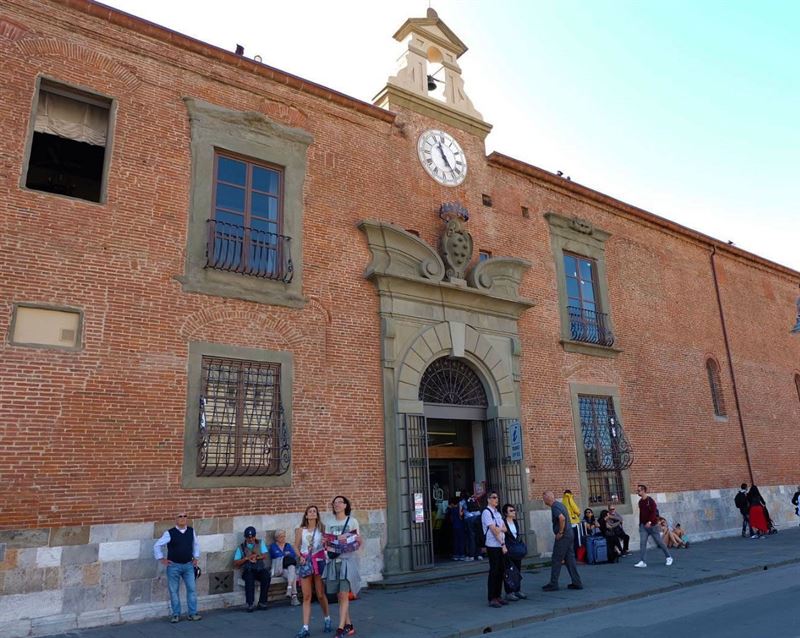
5. Museo dell’Opera del Duomo – the Cathedral Museum
The final piece of the jigsaw lies in the Museo dell’Opera del Duomo – the Cathedral Museum. The museum attempts an overview of the Campo dei Miracoli, including a chronology, which begins in 1064 with the start of work on the Cathedral, followed by the Baptistery in 1154, the Campanile in 1173, and the Camposanto a century later, in 1277. This short burst of fireworks was followed by swift decline as the city’s harbour silted up. By 1406, the city had been conquered by Florence and was about to be eclipsed culturally by that city’s determination to build even bigger and bolder monuments. The museum is packed with 12th–15th-century sculptures and paintings. Giovanni Pisano’s ivory Virgin and Child (1299) is a highlight, using the natural shape of the ivory tusk to give the Virgin her naturalistic stance. There are models to show the construction techniques used to build the domed Baptistery, and to explain the marble-inlay technique used to give all the buildings their intricate exterior decoration. Best of all is the shady cloister, with a spectacular view of the Leaning Tower and the Cathedral.
Address: Museo dell’Opera del Duomo (Cathedral Museum), Piazza dei Miracoli, Pisa
Web: www.opapisa.it -
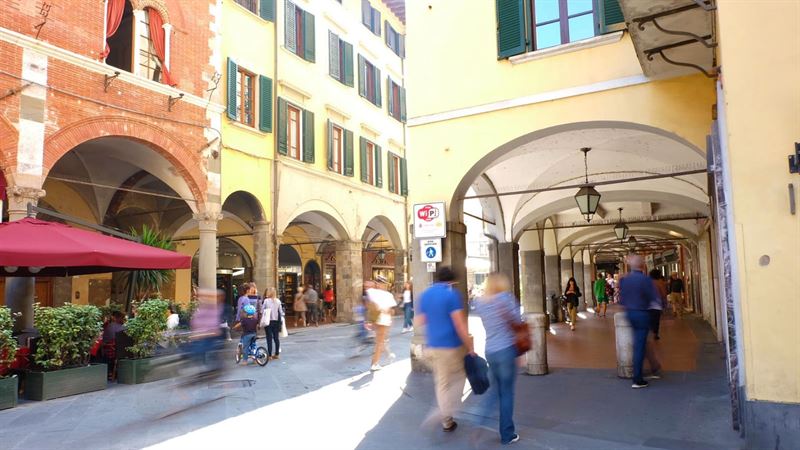
6. Borgo Stretto – for a taste of Pisan life
Pisa is not picturesque, and, beyond the `Field of miracles’, rarely tugs the heartstrings. But there is a warmer side to the city in backstreet Pisa. The Borgo Stretto district is a lively warren of alleyways and shopping streets between Piazza dei Cavallieri and the Arno riverbanks. Lined with cafes and shops, the arcaded Borgo Stretto opens out at Piazza Garibaldi and the Ponte di Mezzo bridge. It’s a perfect place for a wander in search of an ice cream, an afternoon coffee and cake, or a reasonably-priced meal. Call into the Pasticceria Federico Salza (Borgo Stretto 46), an old-fashioned bar and pastry shop, set under the porticoes. It makes a tempting place for an afternoon coffee and cake or evening cocktails. At turns, this pedestrianised street is shabby or chic, with a bohemian feel. Off its southern end, the arcaded Piazza delle Vettovaglie market area is the haunt of Pisa University students who are drawn to the reasonably priced bars. Just beyond, the Arno river is being touted as the Pisan `Left Bank’. Centred on the prestigious university, a large student presence brings energy to the area, as does the presence of Pisan cyclists.
-
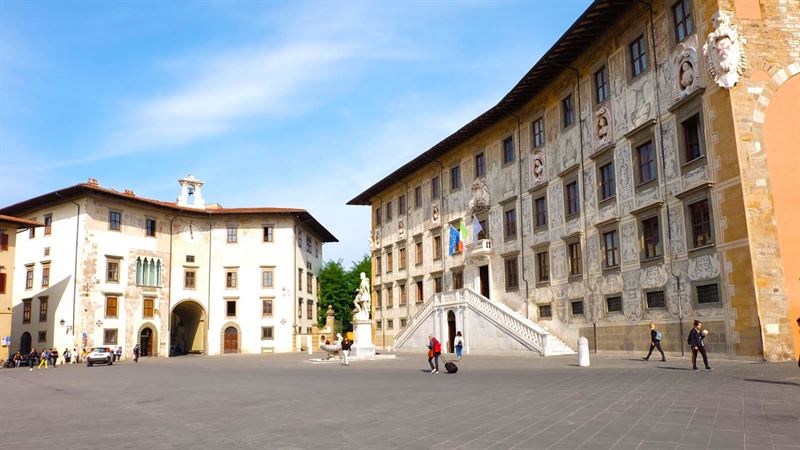
7. Piazza dei Cavalieri – for a peaceful part of town
Critics say that Pisa, unlike its Tuscan rivals, has no real centre. That’s not quite true: it’s simply that the centre isn’t where you most expect it, or that there are several centres. During the Pisan Republic, Piazza dei Cavallieri was the political and administrative heart. Now it’s back to being just a quietly beautiful square. After escaping the hordes by the Leaning Tower, get your bearings back in this deceptively peaceful Pisan square. Dante’s Inferno relates that it was in one of the towers of the Palazzo dell’Orologio (the building with a clock-face to the north of the square) that Count Ugolino, wrongly convicted of treason in 1284, was left to starve to death with his sons. The square is named after the order of knights (cavalieri) founded by Cosimo I (1561) to fight the Turks in the Mediterranean. The duke gave the knights Palazzo della Carovana, the former council chambers of the Pisan City State. The magnificent sgraffito decoration, complete with floral patterns and coats of arms, was based on plans by Vasari (1511–74), as was the next-door church of Santo Stefano. In 1606 Giovanni de’ Medici added the marble façade and the knights’ emblem above the doorway. Displayed inside are trophies and spoils of war from Pisan naval victories against the Ottomans.
-
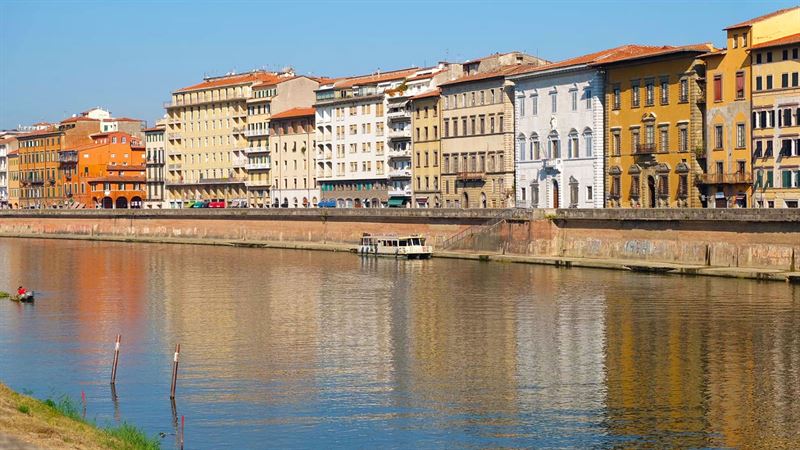
8. Banks of the Arno – for riverside wandering
The `Field of Miracles’ is set on the northern edge of the city, thus distorting the city geography. Pisans themselves prefer to treat the river Arno as a dividing line between different districts. With its steep, stone riverbanks, Pisa is split in two by the gently curving Arno. The riverbanks, known as the Lungarni, are essential Pisa. Depending on the light, the river is inviting or oppressive. On a dull day, the Lungarno presents a procession of blank, ochre facades that merge together, matched by a muddy-coloured river. But on a sunny day, or during a water festival, the Lungarni come into their own. It’s a place for wandering without an agenda, admiring facades and churches, rather than bridges. Ponte di Mezzo, faced with white Verona stone, was once Pisa’s oldest bridge but is now a shadow of its former self. Like most of Pisa’s bridges, it was rebuilt after its destruction by Allied bombing during the Second World War. During a heartfelt summer festival, it feels very different. In June, the Gioco del Ponte, a medieval tug-of-war fought on the bridge, reveals the Pisan sense of belonging. On the opposite bank, across Ponte Solferino, on Lungarno Gambacorti, stands the remarkable church of Santa Maria della Spina. Don’t worry if this Pisan-Gothic gem is closed. The vibrant exterior is what counts, a tour de force of Gothic pinnacles and niches, crowded with 13th-century statues of saints carved by members of the Pisano family. Back in the days when Pisa was a port, before the harbour silted up, seafarers came to pray here before setting sail.
Address: Lungarno Paccinotto, Lungarno Mediceo & Lungarno Gambacorti, Pisa -
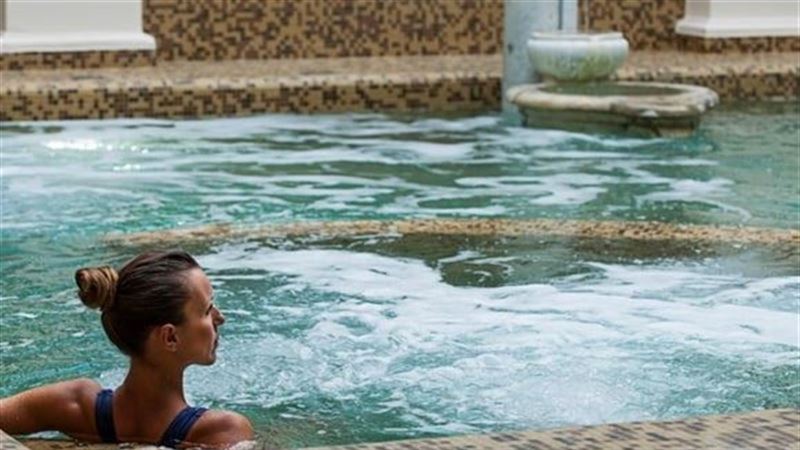
9. San Giuliano Terme – for revitalising hot springs
The charmingly faded spa town of San Giuliano Terme is set midway between Pisa and Lucca, at the foot of the Pisan mountains. Olives, chestnuts and pines grow nearby, while wild horses roam the hills. San Giuliano is renowned for the curative powers of its thermal springs. Here, Bagni di Pisa spa resort is the best place to try out a thermal spa treatment, or simply indulge in some pampering. In its heyday, this atmospheric spa resort played host to the Romantic poets but is still romantic without them. These spa waters have been celebrated since Roman times and are especially good for the treatment of rheumatism and arthritis. Montaigne, Byron and Shelley were famous Grand Tourists who swore by such treatments. Even without any ailments, come for a day spa experience. Wallow in the hot springs and indulge in a treatment or two, including in a grotto pool. The spa experiences include lunch or dinner at the romantic Dei Lorena restaurant, with a distant view of the Leaning Tower of Pisa.
Address: Bagni di Pisa, Largo Shelley 18, 56017 San Giuliano Terme
Web: https://www.bagnidipisa.com/ -
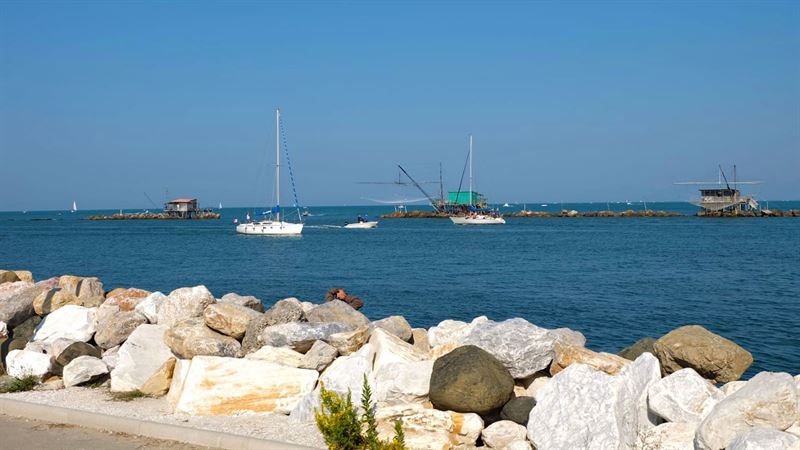
10. The Pisan coast – for a seaside outing
The pretty road from Pisa to the coast follows the Arno to the sea. About 6 km (4 miles) southwest of Pisa, it passes San Piero a Grado, a fine basilica which would once have overlooked the sea. Legend has it that this is the spot where St Peter first set foot on Italian soil. Once at the coast, 12 km from Pisa, you can visit resort of Marina di Pisa, if only for a stroll along the café-lined promenade. If you’re, lucky, there are distant views of the islands of Gorgona and Capraia. Tirrenia, 5 km further down the coast, offers a stretch of pine forest but is still an underwhelming resort compared with the more upmarket Forte dei Marmi, Viareggio or Marina di Pietrasanta, Still, if you’re sated of art and architecture, this makes a pleasant day out, with a seafood lunch, probably involving pasta and clams. From Pisa, the alternative coastal route, going north instead of south, takes in Viareggio and Torre del Lago. This drive best suits opera buffs as it’s a Puccini trail centred on the shores of Lake Massaciuccoli. (It’s covered in an itinerary from Viareggio).
-
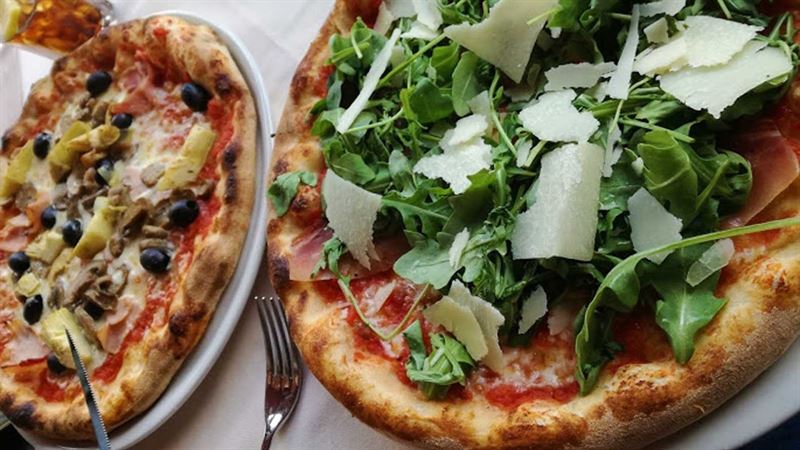
Eating & Drinking
Many dishes reflect Pisa’s maritime heritage, with baby eels on the menu. These are often served as ciechi alla Pisani (in garlic and tomatoes). Seafood dishes include baccalà alla Pisana (dried salted cod) which can be fried or served in a sweet and sour sauce. As well as providing eels, the coastal fish farms also deliver mussels and clams. Unsalted Tuscan bread, made without salt is a staple, and the base of many canapés, or nibbled with prized Monte Pisano olive oil. Protected produce from Pisa and its surrounding territory includes Pecorino cheese, Parco di Migliarino lamb, Pisan beef, San Miniato truffles, pine nuts, mushrooms, and Pisanello tomatoes. Game is also on the menu, along with typical Tuscan meats, such as wild boar and rabbit dishes. Sullo scio, a typical rustic soup, is made with garlic, tomatoes, chickpeas and rosemary. Desserts may come with a rice and chocolate filling or make use of the local honey from the coastal park of San Rossore Massacciucoli.
-
Ristorante La Scaletta
This upmarket fish restaurant is not far from the Leaning Tower and, conveniently, has its own car park. Although pricey, this is the place for seafood-lovers in search of a mix of creative and traditional cuisine. Expect sushi-like raw starters or a shellfish platter, with oysters or shrimps and scallops. Main courses include stuffed octopus in a shrimp sauce, Elba lobster risotto or turbot with caponata sauce.
Address: Via Pietrasantina 107, Pisa
Web: www.ristorantelascalettapisa.com -
Osteria Bernardo
This mid-priced gourmet bistro is set on a charming square, well away from the crowds around the Leaning Tower. The cooking style is creative but based on Tuscan ingredients so more a nod to contemporary taste than full fusion cooking. It’s a small but well-thought out menu with far less emphasis on pasta than elsewhere. Even if they do serve pasta, such as tagliatelle with funghi porcini (ceps) in autumn, more typical is risotto with Stilton cheese, beef in beer sauce or pistachio-crusted lamb.
Address: Piazza San Paolo all'Orto 1, Pisa -
Osteria dei Cavalieri
Just south of Piazza dei Cavallieri, this authentic, friendly inn is unpretentious and reliable. What’s more, it’s no-frills dining in an authentic early 13th-century tower-house. The inn serves hearty local dishes such as clam soup, baked fish, tagliatelle with rabbit, pecorino-stuffed ravioli, Tuscan tripe, T-bone steak, cheese pie or beef with beans. There are also plenty of vegetarian options. Prices depend what you choose but it ranges from very good value to mid-price.
Address: Via San Frediano 16, Pisa
Web: www.osteriacavalieri.pisa.it -
Gusto al 129
This popular pizzeria delivers everything from the classics, such as Pizza Margherita or Quattro Stagioni to the most weird and wonderful combinations. Spins on classic creations include a gorgonzola and ham version, or versions with three types of tomato pizza or ricotta, or tuna and lemon, or pizza with pistachio pesto. Stranger toppings still are cream, orange, and chocolate, as found in the Nutella and cream pizza or the Nutella and pistachio variant. There’s no need to take the weirdest pizza but the chef does have a decent palate.
Address: Via Santa Bibbiana 10, Pisa
Web: www.gustoal129.it -
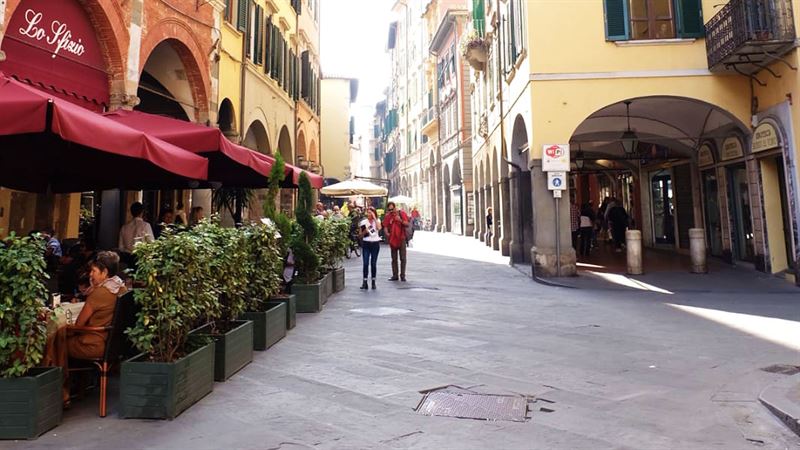
Shopping
Beyond the Leaning Tower, Pisa provides decent shopping, particularly of Italian goods, ranging from jewellery to stylish clothes and tempting food shops. Definitely wander the markets and backstreets, where the locals tend to shop, and look out for antiquarian book stores and sellers of old prints.
Ignore the tacky tourist shops around the Leaning Tower and head to the pedestrianised Borgo Stretto and Corso Italia, the two main shopping streets in Pisa. -
Borgo Stretto
Borgo Stretto starts at Piazza Garibaldi and runs into via Oberdan, the so-called Borgo Largo. The street provides a mix of quirky fashion finds and the smartest, big-brand shopping. Above all, the arcaded Borgo Stretto makes an enjoyable stroll, with stops for coffee, ice cream or cocktails under mediaeval arches.
Address: Borgo Stretto, Pisa -
Corso Italia
Corso Italia, on the opposite bank to Borgo Stretto, links Piazza Vittorio Emanuele II and, ultimately, Piazza dei Cavalieri. By comparison with Borgo Stretto, Corso Italia offers less distinctive shopping but it’s still shopping for all budgets. For books, it’s always worth visiting Feltrinelli.
Web: www.feltrinelli.it -
Pisan markets
Piazza delle Vettovaglie is an enjoyable daily (mornings only) food market lies just off Via Borgo Stretto and offers a feast of fresh Italian produce. On the second weekend of the month, Ponte di Mezzo is an antiques and bric-a-brac market.
-
Enoteca Bacchus
This recommended wine shop sells (and ships) a huge array of Tuscan wines in addition to regional foodstuffs such as olive oil and pasta. They can also do gift packs so make good souvenirs.
Address: Via Pietro Massagni 1, Pisa
Web: www.bacchusenoteca.com -
Centro Arte Moderna
This established art gallery focuses on modern and contemporary art, sculpture and graphic design, with a section dedicated to Pisan artists. The gallery is set on Lungarno Mediceo, one of the most attractive sections of the Arno riverbanks.
Address: Lungarno Mediceo 26, Pisa
Web: www.centroartemoderna.com -
Parking & Getting Around
Pisa, like other Tuscan cities, operates strict limits on traffic in the historic centre. Known as a ZTL, a Limited Traffic Zone, the area is best avoided by car. The ZTL area includes both banks of the river Arno, from Campo dei Miracoli to Lungarno Galilei and upto the church of San Domenico.
If arriving by car, choose the free car park on Lungarno Guadalongo, the riverside close to Fortezza San Gallo, on the southern side of the Arno. This car park is outside the ZTL zone.
The following city map shows parking and cycling options as well as the extent of the ZTL area:
http://www.turismo.pisa.it/en/itinerary/detail/Piazza-dei-Miracoli/
If arriving by train, then take a Lam Rossa (red) bus from Pisa station to the stop at via Cammeo/Piazza Manin or catch a number 4 bus to Piazza Arcivescovado.
To feel like a true tourist, hop in a rickshaw in the area around the Campo dei Miracoli. For a more authentic sense of Pisa, hire a bike from numerous companies close to the same square.
Pisa tourist board
Pisa tourist board on Piazza dei Miracoli, in front of the Leaning Tower, is a good source of tips on bicycle hire and much else.
Address: Piazza del Duomo 7










